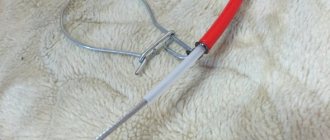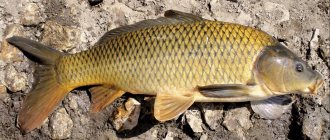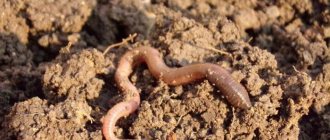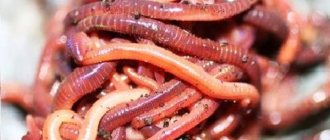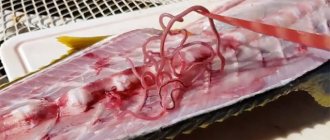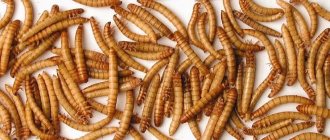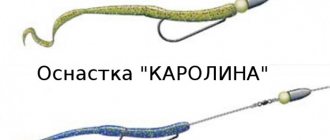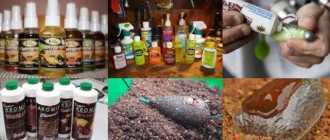Buy quality products at affordable prices in the best fishing online stores
. Give gifts to yourself and your loved ones!
we are in social networks
— subscribe to us on Facebook, Youtube, VKontakte and Instagram. Stay up to date with the latest site news.
The most universal bait among fishermen is the worm. It was used a hundred years ago and is still used today. The worm sits well on the hook and remains mobile for a long time. Fish readily bite on the worm because of its excellent taste and high calorie content. It's like meat for humans.
In this article we will find out which types of worms are suitable for fishing with all peaceful gear. Let's figure out where to look for worms, how to store them, and how to put them on a hook.
Fishermen mainly use the following types of worms:
- Zemlyanoy (crawl)
- dung beetle
- Subleaf
- White
- Green
- Californian
Earthworm for fishing
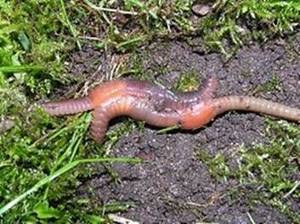
Common earthworms are a very good bait. They sit perfectly on the hook, have a fairly reliable skin and are suitable for angling almost all fish. The most mature specimens are 25 cm long and 8 mm thick. These are suitable for fishing even catfish and large bream, carp and carp. Earthworms are not demanding in terms of storage when fishing. It is enough to place them in a round container with holes and add moist soil to it.
To find an earthworm, you will need a flashlight. They don't need to be mined with a shovel. They find earthworms in damp places. When it rains, they are very easy to collect in sufficient quantities. The best time to collect earthworms is when there is low pressure. In the city, after rainfall, you can often see earthworms appearing on the asphalt.
Myrmeconema neotropicum
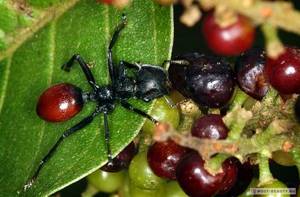
Hardworking ants fall prey to another flat parasite from the Tetradonematidae family. The worms themselves do not exceed 1 mm in length.
The only host is the ant Cephalotes atratus, which lives in South America. After infection, the back of the ant's body increases in size and turns red, resembling a ripe berry.
Such a bright image attracts birds, and they easily find ants in the forest thickets. Birds eat ants, and then the worm eggs, along with bird feces, fall back onto the surface of the earth, are eaten by ants, and the development cycle closes.
11
Dung beetle for fishing
Another great bait are dung worms. They are difficult to confuse with other species. The main distinguishing feature of the dung beetle is its yellow liquid with a characteristic odor. It is this aroma, so to speak, that attracts white fish and makes it actively eat the worm. Crucian carp, roach, bream and other fish are crazy about the dung worm.
It has a bright dark red and burgundy color, and the rings are arranged differently. When placed on a hook, it wriggles very strongly and does not allow itself to be pierced. These worms make very beautiful and attractive bunches. Other baits go well with this worm: maggots, corn, bloodworms, wheat, etc.
It is important to preserve the dung worm when fishing. Especially if fishing takes place in hot weather. In such conditions, it is important to place the worm in a fairly large, airtight container with holes. Moist humus soil is poured into it and a little more tea leaves are added. Some fishermen add a little cake mixed with clay to the container.
In general, every angler knows very well that a dung worm is the bait that should always be available. More than once she became a lifesaver during seemingly unsuccessful fishing trips.
Why do fishermen in different countries choose the dendrobena worm?
There are many reasons for the popularity of dendrobena among fishermen. First of all, dendrobena is considered a universal bait. This worm attracts a large number of fish due to its color and high activity. In addition, it has a special aroma that attracts fish. The worm is large in size: it is easy to put on the hook, and it stays on it well. And the elasticity of the body allows you to maintain the integrity of the bait even when attacked by small fish. At the same time, you can buy dendrobena at any time of the year; the worm is large and fleshy. Excellent for keeping at home. You can fish with dendrobena in both salt and fresh water.
However, in order for your fishing to go without any unpleasant surprises, experts recommend purchasing worms from trusted stores.
In some cases, dendrobena is used not only for successful fishing, but also for bird feed or as a protein supplement when breeding fish in an aquarium; this is an expensive way of feeding, but you will be sure that the protein that the fish receives is completely natural.
White worm
A special type of invertebrate is the white worm. It has a bluish-white color and is found in wet meadows and ravines near water. These worms have a thick body and tough skin. There are even small spines on the body. If we cut it across, we will find a large amount of earth inside. In fact, this is his, not so much his main food, but a product that he processes.
The white worm sits perfectly on the hook. If you are fishing in a lake or fishery where there is an overabundance of small fish, then a white worm is just the thing to save you. A small thing won’t covet him, he’s simply too tough for her. And the size of such a worm is not comparable to the mouth opening of bleak and gudgeon. Perhaps only rotan can eat such a dish.
So in what situations is a white worm needed? If you put a dung or California worm on a hook, cast a fishing rod and see how the little thing destroys the bait in a matter of seconds, then you immediately understand that a different bait is needed. And it will be a white worm. As soon as you throw it with a hook into the water, you will immediately see the float standing level on the water. Yes, the bites will decrease significantly, but crucian carp or other fish will bite. You will not be distracted by frequent and monotonous bites of small things. Fishing will become more measured and meaningful.
Green worm
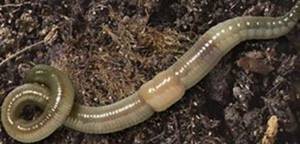
An interesting bait is the green worm. It is good for catching large fish: catfish, tench, carp and crucian carp. This worm has a tough skin. This is why fishermen also call it “wooden”. It can be found in meadows and near rivers. It lives near plants. To dig up green worms you will need a good shovel. These worms are also extracted from the soil in pasture areas. During dry periods, these worms often live in soil that is filled with natural fertilizers.
The green worm sits securely on the hook. However, you need to be able to store it. For these purposes, it is better to use small wooden boxes or canvas bags. If you need to save it until the next fishing trip, then store it in damp soil and periodically add grated potatoes and peeling apples and cucumbers.
Pros and cons of popular types
All worms for fishing have their advantages, but there are also a lot of disadvantages. Often the fisherman's choice falls on the species that is most accessible.
Table No. 1. Pros and cons of earthworm varieties for fishing
| № | Type of worm | Advantages | Flaws |
| 1 | Wild ground species | From spring to autumn you can get it yourself. Distributed everywhere except in permafrost conditions. | Available only in the warm season. The fisherman needs to understand the varieties, since not all wild ones are suitable for fishing. |
| 2 | Aquatic worms | They live on a hook for a long time, as they naturally live in bodies of water. | Difficult to extract from reservoirs. |
| 3 | Dendrobena | Ideal for fishing, especially for large fish. | Difficult to cultivate. In stores it costs more than others. |
| 4 | Prospector and Red Californian | Easily bred in captivity. Suitable for fishing. | Size up to 8-10 cm in length. |
Download the table in .png and .pdf formats
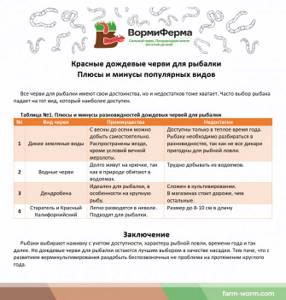
The main advantages of pets
Home-grown red worms for fishing are available all year round

Subleaf
Larger, but less mobile on the hook is the underleaf worm. Fish bite on it just as well as on a dung worm. However, it has a more delicate skin, which is why fish often tear it off without being caught.
The subleaf has a dark red color with a purple tint. Underleaves can be found under last year's rotten leaves, rotten boards, even under old rotten bags and clothes that have been lying in the ground for a long time. The trick to getting these worms is that they need to be found and collected quickly. They are located on the surface, under any objects.
Often subfoliates are found in the water between water lilies and lilies. Crucian carp, rudd, ram, ide and white bream take well on such a worm.
How to properly feed dendrobena?
If after purchasing dendrobena your fishing does not take place within a month, the worms will need complementary feeding. In addition, it is recommended to feed the worms immediately before fishing, even if they were purchased recently.
Despite the widespread opinion among fishermen that dendrobena is best fed with household waste, experts advise refraining from this method of complementary feeding. The reason is that such complementary feeding contributes to the acidification of the substrate, and can also provoke the appearance of other living creatures, for example, midges. It should also be remembered that household waste always contains a high percentage of water, and, as you know, worms will not gain weight from water.
Thus, household waste clearly should not be considered one of the most successful complementary feeding options. A more suitable option is, for example, chicken feed. A very small amount will be required. It does not lead to acidification of the substrate and allows you to avoid the appearance of unnecessary living creatures.
In some cases, homemade food may be suitable. But you should also be as careful as possible with it and monitor its composition. Homemade food for dendrobena is made from bran, rolled oats and other grains. It is believed that food prepared independently is a guarantee that it will not contain salt and sulfur harmful to worms. However, commercially available feeds contain a detailed composition, which means you can always choose what suits you. At the same time, the purchased feed contains the optimal proportions of all its constituent components.
Feed for complementary feeding of dendrobena must be thoroughly crushed. A blender is often used for this. Then you should add a little chalk and straw to it, also in the most crushed form. Straw will help avoid rotting of the substrate, and will also saturate it with oxygen necessary for the development of worms.
The feed should be sprinkled in small portions onto the surface of the soil. After this, it is recommended to add a little water - this will help moisten the soil. Next, you need to carefully observe the behavior of the worms. If all the food has disappeared within 24 hours, it means that you did not add enough food and you should add about the same amount more. However, if the food has not been completely eaten after three days, it means there is too much of it, and it is better to remove the remains so as not to provoke the process of rotting.
One way or another, dendrobena prefers monotonous food. That is, having made a choice once, save the selected feeding mode until fishing.
California fishing worm

Fishing stores often sell California worms. This is a special type of worm that was obtained in laboratories. Its purpose is to process large areas of land, making them more suitable for growing crops.
As practice has shown, the Californian worm is a very good bait for fishing. Externally, it is not much different from the dung beetle or subleaf. Its main difference is the characteristic smell, similar to medicine or something similar. The fish are not against such bait and willingly use Californian worms attached to the hooks of donks, feeders and floats.
This worm has a fairly strong skin and sits well on the hook. It's not easy for the fish to get it off the hook. It should be stored in the same way as dung beetle or foliage.
Heterorhabditis bacteriophora
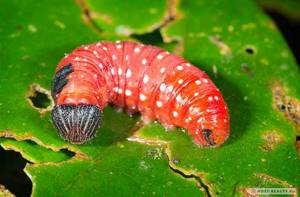
Let’s finish the story with a worm that does not push the prey into the predator’s mouth, but, on the contrary, its effect causes rejection in the predators.
A tiny worm, entering an insect larva, changes its color to bright red. The parasite lives and feeds at the expense of its host, so it is not profitable for it to have the larva eaten.
The red color repels natural enemies, and birds prefer not to eat red larvae. Scientific studies have shown that robins, for example, do not eat red-colored insects at all. This is how the parasite saves the insect's offspring.
Don’t miss out, there is an informative article about the most unusual insects on our website most-beauty.ru.
Methods for placing a worm on a hook
When fishing, you should always remember that the bait should look beautiful. If it consists of living components, it should move. The same applies to worms. We put nimble and nimble worms on the hook. If they hang like a whip, the fish will probably ignore them.
Naturally, the hook must be sharp. With its help it is easy to make neat punctures, and we will not damage the skin. Remember that the hook size must correspond to the hook number. That is, you should not put a large white worm on a small hook.
You can plant the worm through the middle, through the beginning with a stocking, a ring, piercing it in several places. If we catch medium and small fish, then you can attach half a large worm or a whole medium sized one. A bunch of 4-5 medium-sized worms is placed on the bream. The largest earthfish are hooked onto catfish, and also in bunches. In the picture we see different options for attaching worms.

When fishing, after reeling in the gear, we look at what the worm looks like. With a capricious bite, it is very important that it is always mobile, juicy and attractive. Therefore, if we see a shabby crawler or dung beetle on the hook that has lost its presentation, then we change it to another, more presentable one.
It happens that for some reason the crucian carp takes not the whole worm, but its pieces. They are put on a hook with a long shank. In some situations, crucian carp takes so actively that it is even caught on scraps of a worm. On such fishing trips, you can simply cut the worm into pieces and attach them as you use them.
Let's highlight combinations of worms with other baits. Combinations of worms with bloodworms, maggots, corn, pearl barley, and wheat are considered catchable.
How to store a worm
When fishing, we store worms in special worm boxes. These plastic containers are sold in all fishing stores. Even more reliable are round boxes for various skin care creams. You just need to choose more and make holes in the lid. These containers are usually made of durable plastic.
You can step on them and nothing will happen to them. In addition, such boxes are easy to close and open, as they have a reliable thread. It won't be difficult to get them. Every woman uses creams. Just ask her not to throw away the boxes after the cream runs out, but to give them to you.
When fishing, we store the worms in the soil where they are used to living. If it is a subleaf or dung beetle, then we store it in moist soil with humus and last year’s leaves. If it is a white or earthworm, then we store it in moist black soil. The soil should not be too dry or too wet. Cover the box with a damp cloth and keep it in the shade.
If we need to store worms at home, then we will need a wooden box or a small 3-4 liter bucket with holes on the sides and on the lid. We fill it with soil and populate it with worms. Periodically, after a few weeks, we change the soil, but not all of it. Some were poured out, some were added. You can feed the worms by peeling potatoes, apples, carrots and other vegetables. You can add a little milk. We keep the container on the balcony in the shade, or in the cellar.
How to Preserve Worms in Hot Weather
If you are going fishing in a hot place, then you need to additionally think about the safety of the worms. The following video will help you with this:
This is the simplest and most common way to preserve worms for fishing in the heat.
How does dendrobena differ from other worms?
Dendrobena differs in color: as a rule, it is a purple, greenish, red or brown worm. The number of segments that make up its body depends on the age of the worm. The tail is slightly thickened.
An important advantage of dendrobena over other worms is its ability to tolerate even fairly low temperatures. And not only survive in the cold, but also reproduce.
Dendrobena reproduces most actively in early spring. With proper care, this worm can reproduce throughout the year. Cocoons ripen on average 19-30 days. However, the laying of cocoons can only occur in specially created conditions. For example, they should not be kept in too cramped boxes with a large number of other individuals. Since a by-product of the worm’s life is the organic fertilizer vermicompost, it is much more convenient to keep them not in simple boxes, but in specialized worm farms, this makes it much more convenient to extract vermicompost and feed the worms.
The age of the worm does not affect mating, but, as a rule, it is possible to determine that an individual is ready for mating by its weight, which should be more than 1.5 grams (the weight of adult individuals often reaches 7-8 grams).
Where to find a worm for fishing
Village residents easily find worms for fishing. They have many promising places for this. The first is heaps of humus from cattle. Every owner who keeps a cow has such heaps. Also, the heaps are located on the territory of farms and farms. You can easily dig up dung beetles in them. Another promising place is last year's straw. They are also located in the farm area in special brick compartments. The straw deteriorates over time and if you dig a little, you can find excellent red worms there.
White worms can be found in ravines and meadows. Earthworms live in the turf of grass and plants and in flower beds. Large earthworms, which are suitable for fishing for catfish, also live there. They are caught at night with a flashlight when they crawl out of their holes. It takes some skill to catch them, as they are very fast and easily hide in holes.
As for city residents, of course, it is better to buy worms in a store. Find yourself a place that sells worms that suit you and don’t bother yourself looking for this bait. If you want, you can look for worms yourself. They can be found in plantings, under leaves and near streams.

